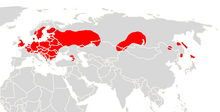Great whiskered bat
| Great whiskered bat | ||||||||||||
|---|---|---|---|---|---|---|---|---|---|---|---|---|

Great whiskered bat ( Myotis brandtii ) |
||||||||||||
| Systematics | ||||||||||||
|
||||||||||||
| Scientific name | ||||||||||||
| Myotis brandtii | ||||||||||||
| ( Eversmann , 1845) |
The Brandt's bat or Brandt bat ( Myotis brandtii even Myotis brandti ) is a bat -Art from the kind of mouse ears , which in 1845 by the German biologist Eduard Friedrich von Eversmann was first described. The scientific epithet brandtii honors the German zoologist Johann Friedrich von Brandt (1802–1879).
features
The great whiskered bat is a rather small species of bat. Their head and torso length is only about four to five centimeters, the wingspan is between 19 and 20 centimeters, the forearm length between 32 and 39 millimeters. A full-grown bearded bat weighs between 4 and 10 grams.
The rather long fur has dark brown hairlines, on top it is golden brown. The belly is gray, sometimes with a yellowish tinge. The ears are moderately long, the tragus is narrow, pointed and about half as long as the ear. Ears, snout and membranes are light brown, the base of the inner auricle and the tragus are usually lighter. In contrast to the lesser whiskered bat, the penis is not uniformly narrow, but thickened in the middle.
distribution
Since the great whiskered bat was previously treated as a species together with the whiskered bat , its distribution has not yet been precisely researched. The animals definitely live in England, Germany, the Benelux countries, southern Scandinavia, Poland, the Czech Republic, Slovakia, Hungary, Romania, the Baltic States, Austria, Switzerland, eastern France and Russia.
Habitat and way of life
The great bearded bat is strongly attached to forests and often to bodies of water. It lives in mixed forest , deciduous forest and sometimes in coniferous forest . In the vicinity of human settlements, it is less common than the whiskered bat. In summer she usually sleeps in tree hollows, but also in buildings and nesting boxes , in winter in caves, tunnels , mines and cellars. Northern populations hibernate .
Large whiskered bats are crepuscular. Fast and agile in flight, they hunt small, non-aquatic insects at low altitudes near bodies of water . When in danger they chirp in high tones, the amplitude maximum is 40–50 k Hz .
Similar Art
- Lesser whiskered bat ( Myotis mystacinus )
Web links
- Photos of the great whiskered bat
- Large bearded bat at NABU Schleswig-Holstein
- Myotis brandtii inthe IUCN 2013 Red List of Threatened Species . Posted by: AM Hutson et al. , 2008. Retrieved January 5, 2013.
Individual evidence
- ^ Murray Wrobel: Elsevier's Dictionary of Mammals. , Elsevier Science & Technology, 2006, ISBN 978-0-444-51877-4 , p. 326.
- ^ Myotis brandtii at Wilson & Reeder's Mammal Species of the World. 3rd edition.
- ↑ a b c IUCN
- ^ Eduard Friedrich von Eversmann: Vespertiliones in Promontoriis Uralensibus Tractibusque Confinibus Conservati. Bulletin de la Société Impériale des Naturalistes de Moscou, 18: 489-516, Moscow 1845 Online at Google Books (p. 505)
- ↑ Bo Beolens, Michael Watkins, Michael Grayson: The Eponym Dictionary of Mammals. Johns Hopkins University Press, 2009, ISBN 978-0-8018-9304-9 , p. 54.
- ↑ a b c Jürgen Gebhard: Bats. Birkhäuser Verlag, 1997, ISBN 978-3-7643-5734-4 , p. 357.
- ↑ Thomas H. Kunz, M. Brock Fenton: Bat Ecology. University of Chicago Press, 2003, ISBN 978-0-226-46207-3 , p. 162.
- ↑ a b c Andrew T. Smith et al. : A Guide to the Mammals of China. Princeton University Press, 2008, ISBN 978-0-691-09984-2 , p. 374.
